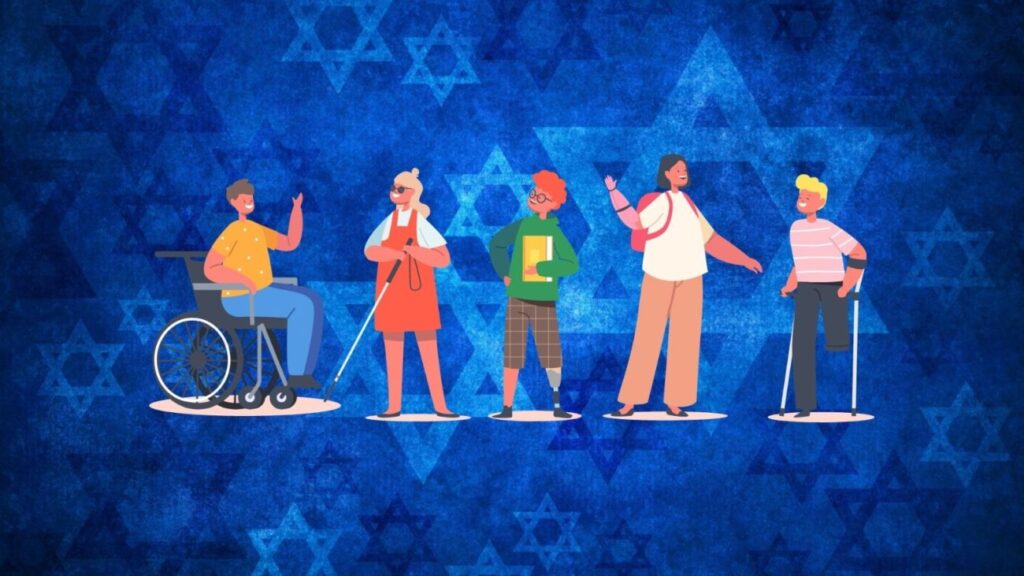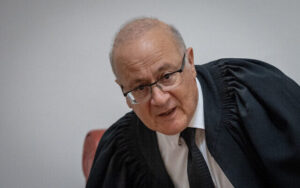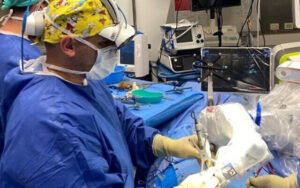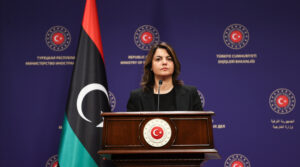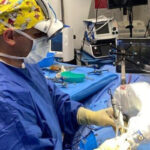אִ֣ישׁ… אֲשֶׁ֨ר יִהְיֶ֥ה בוֹ֙ מ֔וּם, לֹ֣א יִקְרַ֔ב לְהַקְרִ֖יב לֶ֥חֶם אֱלֹהָֽיו – This statement of the Torah, that a man who is not physically wholesome is not allowed to serve at the temple and offer sacrifices, has always been for me a pet peeve, and the attempts of the commentators to explain it did not help much. I felt very uncomfortable with the thought that the Torah discriminates against people with disabilities, especially since my grandfather Hakham Shaul Fetaya, taught me the opposite.
In the late 1970’s my mother Simha, who worked with Bituah Leumi, the Israeli equivalent of the Social Security, was appalled by the way IDF veterans and people with disabilities were treated by her co-workers and the establishment in general. She had long conversations about that with her father, feeling frustrated at being unable to change that behavior. Eventually, she quit her job, and with my grandfather and Dr. Hannah and Israel Openheimer, Holocaust survivors, launched a new initiative.
That initiative was an occupational habilitation center, in which people with physical and mental disabilities learned new skills or revived old ones, in order to integrate into the regular work market. My grandfather’s motto was the verse from Job (31:15): “His maker made me as well, and we were formed in one womb,” and he truly lived by it. The center, in which I was drafted to volunteer since I was 11, became his sole focus, and he rejoiced with every person who left the center for a “regular” position. The center is now defunct, but it has survived for decades against all odds, and even became a model for official centers created by Israel’s Ministry of Health. It helped countless people, who were engaged in real work, operating machinery and producing books and garments, at a time when the establishment sought to isolate, marginalize, and hospitalize them.
It is no wonder that with this upbringing I felt troubled by the exclusion of Kohanim with blemishes from service. What did the commentators have to say? I am starting my search. First is R. Moshe ben Nahman, aka Ramban or Nahmanides (Spain 1194-1270):
לא ירצה להזהיר את אהרן עצמו בתורת המומין, כי אהרן קדוש ה’ כולו יפה ומום לא יהיה בו, אבל יזהירנו על זרעו
There was no need to warn Aaron regarding blemishes, because he was sanctified by God, all handsome without a blemish. The warning is for his descendants.
According to Nahmanides, sanctity, beauty, and physical wholesomeness are the same. Does he suggest that ugliness or a physical blemish indicate a lesser spiritual level? I cannot accept this correlation, let me keep searching. Here is R. Moshe Al-Sheikh (Turkey-Safed 1507-1593):
הנה זה דרך העולם, כי כל איש אשר בו מום לא יקרב, כלומר שום קריבה לשרת לפני מלך, ואם כן איפה כל שכן ללחם אלהי עולם, והוא על דרך (מלאכי א ח) הקריבהו נא לפחתך
It is customary that a man who is not wholesome is not allowed to serve at a human royal court, and it is therefore obvious that the same will be true regarding the service of the Eternal God, as the prophet Malachi (1:8), says regarding a sacrifice.
The reference to Malachi is to a section where the prophet rebukes the Israelites for offering blemished animals as a sacrifice, and he challenges them to bring such animals to a prince or an administrator. It is very hard to accept the analogy Rabbi Al-Sheikh suggests. There is an essential difference between a sacrifice or a gift to a prince, where what is measured is monetary values, and between spiritual or ritualistic service where the intention is what counts. How can we say that the service of a blind or a hunchback Cohen is not as good as that of any other Cohen? Such an analogy shames humanity. Let us move to the next one, R Shelomo Ephraim of Lunschitz, Keli Yakar (Poland 1540-1619):
אומר אני שהקדמונים שהיו בקיאין בחכמות היו יודעין בכל מום שנתהוה באדם טרם היותו מצד איזה עוון שראו בו… דרך משל… מקבל שוחד ידעו בו שסופו בא לידי עיורון, ואם ראו בו רגל גאוה ידעו בו שסופו לבוא לידי שבר רגל
I say that the ancient sages were able to predict future handicaps before they occurred based on one’s sins. For example, they knew that a judge who accepts bribes will lose his eyesight, and one who walks arrogantly will break his feet…
The Keli Yakar suggests that physical handicaps are a result of spiritual ones or of transgression. It seems as if with every generation that passes the commentaries become more difficult to comprehend. This is the kind of religious fanaticism which blames the victims and sees in every disease or handicap a divine punishment. Not only does this approach not help people who are struggling with disabilities, it puts them down by telling them that God wanted them to be that way, because of their actions or thoughts. No, this commentary will not do, I must continue looking. Maybe I will find solace in the writings of R Samson Raphael Hirsch (Germany 1808-1888):
התמימות הגופנית הנדרשת ביחס לשניהם מבטאת גם את שלמות התמסרותנו וגם את שלמות החיים שנזכה בהם בקירבת ה’. מזבח ה’ לא הוקם לצורך שבורים ורצוצים, עוורים ופסחים, נכים ודוויים וחולים; לא לשם כך נבנה המזבח, כדי שהאדם העייף ישתרך למעלותיו וימצא שם ניחומים לאבליו או רפואות פלאים לחוליו… החיים והגבורה, לא המוות והחולשה שוכנים במזבח ה’ …. בעל מום לא יוכל לייצג את האדם המצוי בקירבת האל
The physical perfection required for both (Cohen and sacrifice) expresses the totality of our devotion, as well as the perfection of life we will merit when we are close to God. The altar was not built for the broken and distraught, the blind and lame, the handicapped, the depressed and the plagued. The altar was not built for the exhausted person to crawl on its steps and find comfort for his sorrow or elixirs for his disease… life and rigor, and not death and weakness, dwell at the altar of God… a man who is not physically wholesome cannot represent those who are close to God…
I would have liked to give Rabbi Hirsch the credit and say that perhaps he meant that ideally, a life of Torah can bring humanity to perfection, both spiritually and physically, and one could also argue that the meaning of his words was lost in translation from the original German, but I will not deny that reading these words sent chills down my spine. A religious Jewish text written in Germany praises physical perfection and says that the House of God is not a place for the weak of mind or frail of body. This is too much. I must come with my own interpretation to soothe my soul and to help me ascertain the eternity of the Torah and its divine origin.
The solution, in my opinion, is the possibility that in the ancient world, people with physical disabilities were sometimes considered holy or having special spiritual abilities. Maybe they believed that just as the loss of sight sharpens other senses, the loss of certain physical faculties contributes to the development of spiritual ones. In the bible, there are several hints at that possibility. Moshe is described as having a speech impediment, and God tells him: “who gives man a mouth? And who creates the deaf and the mute and the seeing and the blind? It is I, God!” (Ex. 4:11). In chapter 5 of II Samuel we read of the animosity of David towards the lame and blind people, who seem to have prophesied that he will not be able to conquer the fortress of Yevus. According to the theory suggested here, they could have been pagan priests or prophets.
The prophet Isaiah, after attacking paganism, states (42:19): “Who is blind but my servant, deaf as the messenger I will send? Who is blind as my perfect one – כִּמְשֻׁלָּ֔ם, blind as the servant of God?” Isaiah seems to suggest that imperfection makes one closer to God. Much later, Rabbenu Gershom (Germany, 960-1028), writes in his commentary on the Talmud (Menahot 109:2), that Rav Yosef and Rav Sheshat blinded themselves to achieve the spiritual level of their master. Today, many people believe that autistic children are clairvoyants or prophets.
If this was a prevalent belief in antiquity, then it is also possible that parents would have maimed their children to guarantee them a life of holiness or service at the temple. In order to prevent that from happening, the Torah barred all people with disabilities from serving at the temple. In that manner, it discouraged parents from causing harm to their children, even though the rule would also affect those who were born that way. That was done because it would have been very hard to discern at the age of twenty, in which the Kohanim started serving at the temple, which disability was there from birth and which was acquired later in life.
Support for this idea can be found in the Midrash Halakha on Leviticus, which says that the prohibition should have logically applied only to disabilities acquired later in life. This confirms my suggestion that the Torah wanted to deter parents from maiming their children.
It might seem preposterous to some of us that parents might cause harm to their children in the belief that it is good for them, but we can cite the Chinese practice of foot-binding, done to create beautiful, small feet, at the cost of excruciating pain. Not only that, it was done to young girls by mothers who suffered through the same process at childhood. This practice was almost banished in the early 1900’s, but parents find new ways to hurt their children in their (the parents’) quest for success, and here’s is one example: between 1990 and 2005, an estimated 425,900 children from 6 to 17 years of age were treated for gymnastics-related injuries in U.S. emergency departments.
I have been asked by people to whom I have presented this theory, whether today we are more knowledgeable then the early commentators cited above. My answer is that we are, in many senses, more knowledgeable and more sensitive. Life has changed so much and our knowledge of the world and humanity has grown immensely.
Medieval Europe, as well as Rabbi Hirsch’s Germany, are worlds away from us, and there is no reason to believe that if Nahmanides, Rabbi Al-Sheikh, and Rabbi Hirsch would have lived today, they would have stuck to their interpretations. I am sure that they would have studied the new world and its understanding that one should not be discriminated against because of gender, race, or physical conditions, and would have adjusted their interpretation of the Torah to the new reality, because they were great scholars.
May we continue to grow spiritually and emotionally, and to be attentive and sensitive to the needs and difficulties of others.
Questions on Parashat HaShavua
שְׁאֵלוֹת לְפָרָשַׁת הַשָּׁבוּעַ: אֱמוֹר
- What did HaShem tell Moshe to tell the Kohanim?
- What are the Kohanim not allowed to do?
- When are Kohanim allowed to participate in a funeral?
- Which holiday falls on the 15th of Nissan?
- What is the definition of מְלָאכָה?
- When are we not allowed to do מְלָאכָה?
- From which day did Bene Israel bring the Omer to the Kohen?
- How many days between Pesach and Shavuot?
- Which holidays do we have in the month of Tishre?
- There is one day in which, in addition to not working, we also have to fast. Which day is it?
- On which holiday do we blow the Shofar?
- What are the two things which must always be in the Mishkan?
- Where do the Kohanim eat the Challot?
Answers for Parashat HaShavua – אֱמוֹר
- The things they are not allowed to do.
- They are not allowed to be near a dead body because they are holy.
- When one of the close relatives passes away: Father, mother, brother, sister, son, daughter, wife. Also when there is a dead person and there is no one to take care of his burial.
- Pesach.
- Creative work.
- On Shabbat, Yom Kippur, and Yom Tov.
- From the second day of Pesach.
- 49 days – 7 weeks.
- Rosh HaShana, Yom Kippur, and Sukkot.
- Yom Kippur.
- On Rosh HaShana.
- A pure oil for the Menorah and 12 Challot for Lechem HaPanim.
- In a holy place.

